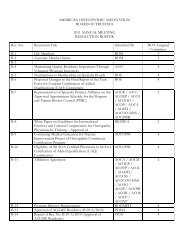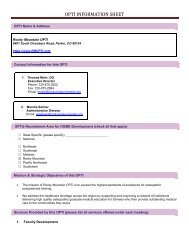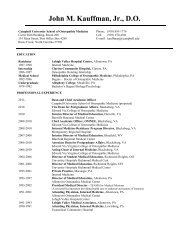Dialogue and Diagnosis - American Osteopathic Association
Dialogue and Diagnosis - American Osteopathic Association
Dialogue and Diagnosis - American Osteopathic Association
Create successful ePaper yourself
Turn your PDF publications into a flip-book with our unique Google optimized e-Paper software.
PATIENT<br />
DIALOGUE<br />
Are GLP-1 receptor<br />
agonists like insulin?<br />
Although both GLP-1 agonists <strong>and</strong><br />
insulin are administered by means of<br />
subcutaneous injection <strong>and</strong> are relatively<br />
potent in their glucoselowering<br />
effects, they differ in several<br />
important respects. Most<br />
importantly, unlike insulin, GLP-1<br />
receptor agonists are associated with<br />
a very low risk of hypoglycemia.<br />
Patients can be reassured that these<br />
agents work only when glucose levels<br />
are high. In contrast to the use of<br />
insulin therapy, which is often associated<br />
with weight gain, the use of<br />
GLP-1 receptor agonists to manage<br />
hyperglycemia may have the<br />
additional benefits of lowering body<br />
weight, systolic blood pressure, <strong>and</strong><br />
triglyceride levels—all of which may<br />
be elevated in patients with T2DM.<br />
Clinical trials comparing GLP-1<br />
receptor agonists with insulin have<br />
shown that GLP-1 receptor agonists<br />
lower blood glucose levels to levels<br />
similar to when insulin is adminis -<br />
tered, but with less weight gain <strong>and</strong><br />
hypoglycemia. 32,40,41 In addition,<br />
treatment satisfaction has been<br />
reported to favor GLP-1 receptor agonists<br />
over insulin, independent of<br />
weight effects. 42<br />
Availability, dosage, <strong>and</strong><br />
administration<br />
Liraglutide is available as pen sets,<br />
with each pen delivering a dose of<br />
0.6 mg, 1.2 mg, or 1.8 mg. Patients<br />
will use 2 pens per month at a dosage<br />
of 1.2 mg daily <strong>and</strong> 3 pens per month<br />
at a dosage of 1.8 mg daily. Patients<br />
may administer injections at any<br />
time of day, independent of meal -<br />
times, but preferably at the same time<br />
each day. The starting dosage is<br />
0.6 mg daily, which is not a clinically<br />
effective dose but rather a dose to<br />
acclimate the patient to possible<br />
gastrointestinal adverse effects (eg,<br />
nausea, vomiting). If tolerated, the<br />
GLP-1 receptor<br />
agonists to manage<br />
hyperglycemia may<br />
have the additional<br />
benefits of lowering<br />
body weight, systolic<br />
blood pressure, <strong>and</strong><br />
triglyceride levels.<br />
starting dosage is increased to<br />
1.2 mg daily. Some patients may<br />
require further dosage escalation to<br />
1.8 mg daily; glucose-lowering <strong>and</strong><br />
weight effects are dose related. 43<br />
Exenatide is available in 5- <strong>and</strong><br />
10-g fixed-dose pen devices. 35,36<br />
Patients typically start treatment with<br />
a dosage of 5 g twice daily, administered<br />
before meals. Patients may take<br />
their doses before lunch <strong>and</strong> before<br />
the evening meal if they do not eat<br />
breakfast. The dosage may then be<br />
titrated to 10 g twice daily as<br />
indicated <strong>and</strong> tolerated. Exenatide<br />
should be administered from 60<br />
minutes to immediately before<br />
meals—with less nausea reported<br />
when given closer to the meal, but<br />
with maximum satiety when given 1<br />
hour before the meal. The 2 daily<br />
doses should be at least 6 hours apart.<br />
Exenatide extended release, which<br />
was approved for use by the Food <strong>and</strong><br />
Drug Administration in January<br />
2012, is administered once weekly. 36<br />
It is available in single-dose trays,<br />
with each tray providing an injection<br />
of 2 mg exenatide. Thus, patients<br />
receive 4 trays per month. Patients<br />
may administer injections at any<br />
time, without regard to mealtime.<br />
Because of its very long half life,<br />
<strong>Dialogue</strong> <strong>and</strong> <strong>Diagnosis</strong> // September 2012<br />
19

















